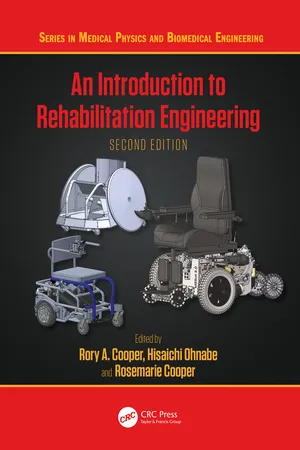
An Introduction to Rehabilitation Engineering
- English
- ePUB (mobile friendly)
- Available on iOS & Android
An Introduction to Rehabilitation Engineering
About this book
In response to the growing demand for a foundational resource in rehabilitation engineering, Dr. Cooper – renowned innovator and leader in the field – joins a team of knowledgeable contributors to present the fully updated Introduction to Rehabilitation Engineering, Second Edition. This comprehensive guide introduces both foundational principles and real-world applications of rehabilitation engineering (RE), making it an essential text for students, educators and professionals alike. Covering 18 in-depth chapters, this edition explores key areas such as wheeled mobility, prosthetics, orthotics, rehabilitation robotics, accessible transportation, universal design, digital accessibility and adaptive sports technologies. It integrates core concepts like the PHAATE model and participatory action design and engineering (PADE) with practical insight into standards, service delivery, ergonomics and universal design while providing a well-rounded understanding of how engineering can improve function, independence and quality of life.
Structured with clear learning objectives, chapter-end study questions and a comprehensive glossary, this book supports both academic instruction and lifelong learning. With a focus on usercentered design and interdisciplinary collaboration, it equips readers to meet the challenges of modern rehabilitation engineering with creativity, understanding and technical expertise. Whether beginning a journey in rehabilitation engineering or seeking to deepen knowledge, Introduction to Rehabilitation Engineering, Second Edition, offers a concise yet thorough foundation in a critical and rapidly evolving field – inviting further exploration, innovation and impact. These features make the book a valuable resource for students, practitioners and anyone interested in the field of rehabilitation engineering.
Key Features:
• Covers essential topics such as device design, service delivery models, universal design principles and technology transfer mechanisms.
• Emphasizes real-world applications of RE, including areas like wheelchair design, prosthetics and orthotics, web accessibility and communications technology, robotics in rehabilitation and adaptive sports, offering readers a tangible understanding of how these technologies impact daily life.
• Serves as a concise yet thorough introduction, providing readers with a solid foundational understanding of RE, while stimulating further exploration and research in the field.
Frequently asked questions
- Essential is ideal for learners and professionals who enjoy exploring a wide range of subjects. Access the Essential Library with 800,000+ trusted titles and best-sellers across business, personal growth, and the humanities. Includes unlimited reading time and Standard Read Aloud voice.
- Complete: Perfect for advanced learners and researchers needing full, unrestricted access. Unlock 1.4M+ books across hundreds of subjects, including academic and specialized titles. The Complete Plan also includes advanced features like Premium Read Aloud and Research Assistant.
Please note we cannot support devices running on iOS 13 and Android 7 or earlier. Learn more about using the app.
Information
Table of contents
- Cover
- Half-Title
- Series
- Title
- Copyright
- Contents
- Foreword
- Preface to the Second Edition
- List of Contributors
- About the Series
- The International Organization for Medical Physics
- Chapter 1 Participatory Action Design and Engineering
- Chapter 2 Rehabilitation Engineering in Practice
- Chapter 3 Accessible Home and Worksite Design
- Chapter 4 Technology Transfer
- Chapter 5 Standards for Assistive Technology
- Chapter 6 Seating Biomechanics and Systems
- Chapter 7 Tissue Integrity Management
- Chapter 8 Wheelchairs
- Chapter 9 Therapeutic Electrical Stimulation
- Chapter 10 Accessible Vehicles and Transportation Systems
- Chapter 11 Rehabilitation Robotics
- Chapter 12 Major Limb Prosthetic Devices
- Chapter 13 Orthotic Devices
- Chapter 14 Aids for People Who Are Blind or Visually Impaired
- Chapter 15 Maximizing Participation for People with Hearing Loss
- Chapter 16 Information-Communication Technology and Digital Accessibility
- Chapter 17 Augmentative and Alternative Communication Technology
- Chapter 18 Adaptive Sports and Recreation Technology
- Index